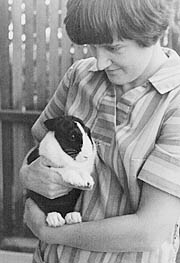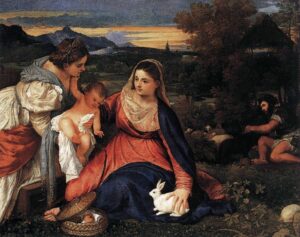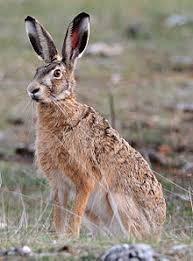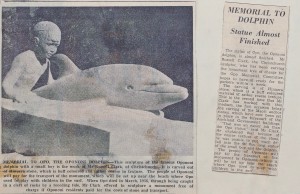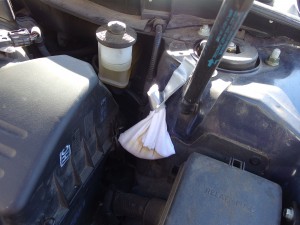Archive for the ‘animals’ Category
Sitting down with lions
In many cultures, humans see themselves as siblings to other living beings. In Aotearoa New Zealand, where I grew up, the Māori people recognize landforms such as mountains and rivers as their relatives. Even in Western Judeo-Christian societies, where humans are believed to have been make in God’s likeness and to have dominion over all creatures (Genesis 1:26), people with beloved domestic pets may discover that their relationship is closer to that of peers than of master and subject.
My own views, which come closer to those of scientific pantheism, had a formative moment one summer day in the early 1970s, when my friend Judi and I took our children to the Oakland Zoo. I tell about it in a letter to my parents:
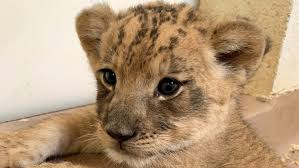
A lion cub recently born at the Denver Zoo. Image from the Denver Post.
The biggest thrill of the day, I got to cuddle a lion cub. Little 7 week-old roly-polies, they had been separated from their mother – I gather the father was threatening to harm them in the cramped quarters of the adult lions. We happened to be there at bottle time, and the keepers brought them out to a low platform in the children’s zoo. They obviously need lots of affection. I was sitting on the platform, and one of them just crawled into my lap, like a kitten or a puppy.
I will remember always the roughness of the cub’s fur under my hand, the warmth of his tiny body, the loudness of his purr, the overwhelming sense of awe that this wild creature trusted me. Here’s a poem about the incident:
The Lion Cub
In the dusty heat of the zoo
a lion roars.
I conjure a dream of Africa
an endless veldt
an alien majesty
concealed in yellow grass.
At the petting zoo
three lion cubs
explore a patch of dirt.
I sit.
One crawls into my lap
nuzzles my hand.
Under thick baby fur
muscles ripple, relax
curl up for a nap.
Wide-eyed, the children watch
and touch.
Distance evaporates.
We are earth family
connected deep in time
in mother love.
The Easter Bunny mystery
How could my husband and I be so mean as to deny our kids the Easter Bunny? I frowned as I reread the letter to my parents stashed in my old black filing cabinet.
12 April 1971
The kids are back at school today after their week of Easter vacation. The weather has been so beautiful and spring-like. This is something I couldn’t really understand until I came to the northern hemisphere—the significance of Easter as a spring festival—the death and rebirth of the god that is an important part of almost every religion there has ever been. Here a big thing at Easter is the Easter Bunny, who is alleged to bring baskets of candy eggs and goodies to kids on Sunday morning. This Tony and I just can’t go along with—somewhat to the kids’ disappointment, I think, though we do buy them a fancy Easter egg, and of course we have the fun and mess of dyeing hard-boiled eggs and hiding them in the garden for an egg hunt. I did allow Simon to share our pet rabbit at school one morning. Bun-Bun was less than enthusiastic about the whole project, but the children were ecstatic.
Part of the reason for our rejection of the Easter Bunny was that Tony and I grew up in New Zealand, where rabbits were despised as pests. Brought by early settlers to a place with no natural predators, their population quickly reached plague proportions, causing major erosion problems. We did have Easter eggs, but given that we celebrated the festival in the Southern Hemisphere autumn, they had no significance other than as a source of sugar and chocolate. Even living in California, we couldn’t see any connection between rabbits and the Christian celebration of the Resurrection. I decided this week to look into the question. I quickly found myself down a fascinating rabbit hole of customs, beliefs, and theories, many of them contradictory.
How the Easter Bunny came to the U.S. seems pretty clear. According to several sources, the creature first arrived in America in the 1700s with German immigrants who settled in Pennsylvania and transported their tradition of an egg-laying hare called “Osterhase” or “Oschter Haws” who brought colored eggs to good children at Easter. As the custom spread across the U.S. the hare somehow transformed itself into the more familiar rabbit and its Easter morning deliveries expanded to include chocolate and other types of candy and gifts.
The hare’s (or rabbit’s) connection with Christianity are more complicated. For the first few centuries, the Christian festival coincided with the Jewish Passover, which is when the historical events surrounding Jesus’s death occurred. Though the Christian calendar has since been modified, both festivals are still close to each other in spring. Both are based on a lunar calendar; the date of Easter was defined in 325 CE by the Council of Nicaea as the first Sunday after the first Full Moon occurring on or after the vernal equinox. In Anglo-Saxon regions of Northern Europe, the Christian festival seems to have merged with a pre-existing equinox festival honoring Eostre, the goddess of spring, and Christians continued to use the name of the goddess to designate the season. Since hares and rabbits give birth to large litters in early spring, they have long been recognized as symbols of the rising fertility of the earth at the vernal equinox.
No, no, no, say some Catholic writers. The Easter Bunny has Christian origins. The ancient Greek philosopher Aristotle observed that the hare could conceive again while pregnant, thus shortening the time between litters and delivering more offspring during a breeding season. Later Greek writers such as Pliny and Plutarch expounded the notion that hares (and rabbits, by association) were hermaphrodite, and thus could self-impregnate and reproduce as virgins. During the medieval period, hares and rabbits began appearing in illuminated manuscripts and paintings depicting the Virgin Mary, serving as an allegorical illustration of her virginity.
Two pregnancies at once? Intrigued, I veer into another passageway of my research rabbit warren. It turns out that, as the Smithsonian Magazine put it, “Aristotle got it right: the European brown hare (Lepus europaeus) can get pregnant while it’s pregnant.” In 2010, scientists of the Leibniz Institute for Zoo and Wildlife Research (IZW) in Berlin, Germany, led by Dr. Kathleen Roellig, published the results of their study. Using selective breeding and high-resolution ultrasonography, they showed that a male hare can fertilize a female during late pregnancy. The resulting embryos will develop around four days before delivery of the first pregnancy. To quote from the Smithsonian article: “The embryos don’t have any place to go at that time, however, since the uterus is occupied by the embryos’ older brothers and sisters. So the embryos hang out in the oviduct, rather like when you wait in your car for a parking space to open up. Once the uterus is free, the embryos move in.”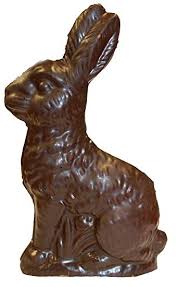
My head is spinning. I think I need chocolate.
Dolphins of Yesteryear
A 55-year-old news clipping brings back memories
An old black metal filing cabinet sits in my cluttered attic. Stuffed into its four drawers are fifty-five years of my stories, some published, most not. Sooner or later someone will have to dispose of all the dog-eared pages and travel-worn manuscript boxes. In the meantime, I’ve set myself a little project for this blog: go through the files and find pieces of my past that you, my readers, might find interesting.
Here’s one, to start us off. On January 6, 1960, I was fresh out of college, and this was my first day on the job as a cub reporter at The Press, Christchurch, New Zealand’s morning newspaper. My boss, the city editor, handed me a four-year-old clipping about the death of Opo, a bottlenose dolphin who chose to join children at play in the surf at Opononi, a beach settlement in the Northland region. The grieving residents had commissioned a statue. “Here, update this story,” he said. “The sculptor lives in Christchurch. His phone number’s in the book. I’ve heard he’s nearly finished.”
I had a pleasant conversation with Russell Clark, the sculptor, who was making the sculpture free of charge as his tribute to Opo. It is of Hinuera stone, which is buff colored and coarse in texture. The sculpture was indeed nearly finished, and would be shipped to Opononi the following week. I was so proud when my little story appeared exactly as written, along with a nice photograph, in the next morning’s edition, having survived unscathed the eagle eyes of The Press’s copy editors, gruff eminences who ruled from a curved dais in back of the press room.
I did not meet Opo, but have my own dolphin memory. We were returning from a family vacation on Tuhua, an island offshore from Tauranga. The day was brilliantly sunny, the launch was bouncing through waves, and I had just learned that I’d been awarded a national scholarship to attend university. A school of dolphins surrounded the boat. Leaping joyously through the waves, they escorted us back to land. As I stood at the bow, I felt like a princess.
Mousebags
For the third time since we moved to the Mendocino Coast, we’ve had an expensive car repair caused in part by mice chewing on the electrical cables. Time for another garage clean-up, and time to get serious about deterring the little darlings. We hied ourselves down to Mendocino Hardware to check out our options. Mousetraps? No. The field mice have a right to live, just not inside the building. Tony spied a gizmo that emits an ultrasonic squeal, which they’re supposed to not like. I was dubious; ultrasonic stakes installed in the vegetable garden a while back had no effect whatsoever on the gophers and voles. I picked up a can of something called Nature’s Defense. Organic, the label said. I scanned the ingredient list. Garlic, cinnamon, clove, white pepper, rosemary, thyme, peppermint. Hmmm! Interesting combination of smells. We decided it was worth a try.
On opening the can, we discovered that the smelly material was in granules that tended to clump together. The next challenge was how to contain it under the hood. I remembered that when I was a child, a favorite gift to sew for my grandma was a lavender bag. While the clipped lavender dried in the shed, I would rummage through my mother’s box of fabric scraps, drawing pieces of voile and dimity through my fingers, feeling their softness, hearing their colors sing to each other. I would stitch my neatest stitches to make a tiny bag, decorated with fragments of lace and a ribbon to draw in the top.
I figured the mice wouldn’t appreciate dimity and lace. But there was an old undershirt of Tony’s in the rag bag. I pulled out my sewing basket, threaded a needle, and set to work. Memories came flooding back as I sewed.
Filled and tied with string, the little bags are now fastened with duct tape around the engine. The car smells a bit garlicky, especially when we switch on the fan, so we’re trying to remember not to. It’s too early to tell how effective the repellant will be. I’ll let you know in a few months.
Prison Guard-ening
On top of the roadbank, I am fastening circles of heavy wire mesh around young Leyland Cypresses. A passing neighbor calls a greeting. “Prison guard-ening?” she asks.
“Yeah,” I reply with a shrug of despair. She too is a gardener. She understands.
Ever since my husband and I built this house at the edge of the forest, we have tried to live in respectful community with the creatures who were here before us. Jackrabbits, foxes and bobcats use our ground-level front porch as a convenient highway. My vegetable garden is fenced off, but the resident blacktailed deer amble through the rest of the garden wherever they please. They even help by pulling juicy weeds from among the deer-resistant perennials and by keeping down the path to the compost bins more efficiently than a lawn-mower.
The only problem I have is with the bucks, who scrape off the velvet covering their antlers by rubbing them against young trees and shrubs. Already some of the cypresses show the telltale signs: a snapped-off branch or frond turning brown, a length of the trunk rubbed raw. It’s a mating signal, I understand, with several facets: the visual sign left by the buck’s rubbing, chemical signals from glands on the buck’s face, and the sound of the buck thrashing branches of the tree on which it is rubbing. I once watched a large buck do battle with a stiff and spiny Ceonothus bush by the driveway. Again and again he attacked, as if determined to demolish it. Here on this roadbank I have lost a Pacific Wax Myrtle and a couple of Shore Pines to such opponents. The Cypresses are a replacement, to help fill in a windbreak against our fierce nor’westers. I can’t afford to lose them too.
The prison cages are unsightly, and don’t fit with the natural landscape I’d like to have. But Cypresses grow quickly; soon their foliage will hide the wire. Sometimes compromises must be made.
Return of the Gray Fox
The gray foxes are back in our Mendocino neighborhood, a meadow at the edge of the forest. We’ve seen them several times, mostly at twilight. They use our low-to- the-ground front porch as a highway. One sat for a long time at the edge of the driveway, observing the meadow. A few evenings ago Tony called me to a back window. On the hill above the wall, a fox was eagerly digging at a gopher hole. A few moments earlier I had seen its mate running up the middle of the road, and soon there were two moving side by side into the thicket. I’ve heard them bark, a raspy single note, like a cough.
Although gray foxes are typically crepuscular, we’ve seen them in broad daylight too. As we were walking across the commons yesterday, not long after noon, a fox dashed across our path with some small creature in its mouth, probably a vole or gopher. It’s likely that nearby was a nest burrow where hungry kits were waiting to be fed.
There’s a nice description of the gray fox, with pictures, in the newsletter of The Watershed Project.
